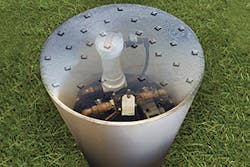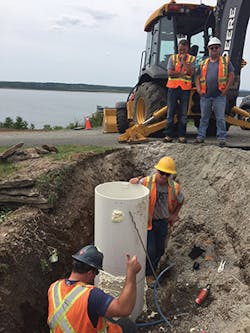The Cape Breton Regional Municipal (CBRM) Water Utility in Nova Scotia supplies potable water to a population of 81,000, which is distributed over 478 miles (770 km) of pipeline. To do this, they operate, maintain, and manage five water treatment plants, six pumping stations, 11 water storage tanks, eight sources of supply, 2,900 fire hydrants, 28,700 water meters, and thousands of valves.
All municipal water distribution systems require flushing to maintain chlorine residual levels and prevent the buildup of biofilms. CBRM, like many municipalities of its size, uses a variety of conventional flushing methods for discharging stagnant water, including service “bleeder” lines (operating 365 days a year) and periodic manual hydrant flushing. This results in over tens of millions of gallons of treated water going back into the environment.
The cost of non-revenue water (NRW) represents a significant cost when you consider the expense of treating and pumping water throughout the distribution system. Real costs of non-revenue water are difficult to determine per flush event, as operational costs and asset depreciation are also difficult to ascertain. Quantifying the volume of water lost through conventional flushing methods versus an automated flushing device is the goal achieved in this article.
When Greg Campbell, CBRM Water Utility’s Water Systems Engineer, viewed a presentation on automated programmable flushing at the Municipal Public Works Association of Nova Scotia in the spring of 2017, it became obvious that there was a relatively easy and inexpensive fix to significantly reduce the NRW problem occurring at their MacLeod Street flush point in Sydney. The presentation showcased the neighboring town of New Glasgow’s “auto flushers” that save an average of 8 million gallons per auto flusher annually. The town of New Glasgow installed eight automated flushing devices, all Hydro-Guard HG-8 models, within one year.
Mueller Canada consulted with the CBRM Water Utility in the months following the presentation and went to the site to better understand the logistics of adding an HG-8 to the MacLeod Street service “bleeder” line. It was quickly determined that this would be an easy installation, and that the local water utility was demonstrating some innovative thinking in the installation process.
The existing service “bleeder” line used for conventional flushing had an old Mueller inverted key curb stop which remained fully open, controlling the water flushed through a ¾-inch polyethylene tubing to the atmosphere. The Hydro-Guard HG-8 was attached to the existing curb stop as a reliable connection for the flusher’s outlet line. Though a curb stop was not required for the automated flushing device’s outlet connection, the municipality did not want to jeopardize the service “bleeder” line’s integrity, since it had been dependable for years of daily use at a relatively high pressure. By adding a new Mueller Oriseal curb stop on the inlet connection of the automated flushing device and an adjustable arch base service box, the flushing unit was quickly connected. All that was left to do was return the gravel and softly compact the ground over the installation area.
Louie Margettie, CBRM Water Utility Supervisor, left the site just one hour after excavation revealed that the old Mueller inverted key curb stop and the relative service “bleeder” line were still in good working condition and could be used to connect the HG-8 automated flushing device. “At this point, it became clear that this was going to be an easy installation by using the existing curb stop and service bleeder line,” says Margettie.
It’s important to ensure that flushing units are suitable to the environment in which they are operating. In colder climates, like Cape Breton, where winter temperatures can be consistently below freezing, it is necessary to place mechanical components in the ground below frost depths. This can add a degree of difficulty when it comes to accessibility. To overcome this challenge, the internal components of the HG-8 are mounted on a movable platform that is connected to the inlet and outlet piping. This arrangement allows the platform to be easily raised to the surface by one person and then lowered back for normal operation. At the surface, the HG-8 installation is only evidenced by its composite lid at the ground level. If the municipality feels it is necessary, extra security from public tampering may be added by using a 30-inch diameter frame and cover. The HG-8 eliminates flushing noise and vibration, which means the public isn’t aware or concerned with flushing events unlike other flushing approaches that discharge water to the atmosphere.
The water utility currently has the unit set to flush twice daily, instead of 24 hours per day, and is maintaining acceptable chlorine residuals. Flushing is scheduled when demand is low, which results in less disruption to water customers and still provides consistent, safe, clean drinking water. Automated flushing is less expensive, wastes less water, and is safer and less visible to the public. This unit alone is expected to save nearly 5 million gallons of water annually.
There are many options for automated flushing, and most can be easily installed using existing water infrastructure; for example, discharge outlet lines can ideally be plumbed to storm sewer manholes or swales. Many automated flushing units also have the capability to add accessories for real-time analysis using two-way communication with existing SCADA systems. These options can be very useful in times of unusual weather events like flooding or large snow accumulations. CBRM installed a Neptune positive displacement ND customer meter to the unit on MacLeod Street and can accurately measure flow at the flush point.
If one 3/4-inch service line at 115psi can displace over 5 million gallons of water annually into the environment, imagine how many of these service lines and other bleeder or flush lines behave in a similar manner in other municipalities. These numbers become staggering when you look at NRW as a global issue. With innovation on the part of CBRM and collaboration with local suppliers, a smart solution to conventional flushing became an instant success, saving the utility $2,284 annually. CBRM compares their water savings value to real water cost vs. billed rate. Using this approach, return on investment of the flushing equipment is realized over just 2 years. However, in areas where water is scarce, it can be assumed that any water saved can have the retail rate applied to calculate cost savings. The water recovered will generate substantially greater cost savings when it can be sold to paying customers.
Greg Campbell and Louie Margettie thought outside of the box when they decided to utilize the existing bleeder line to minimize installation effort and cost for their HG-8. This approach saved thousands of dollars in excavation, prompting CBRM to address other service bleeder lines in their distribution systems with the same proactive automated flushing approach. Not only is the municipality saving 5.7 million gallons of safe clean drinking water per installation annually, they are practicing responsible environmental stewardship by protecting water as a resource. Louie Margettie concludes, “As we continue to recover costs on non-revenue water at strategic flush points, we now have more resources to put forth in maintaining and repairing our aging distribution network.”

